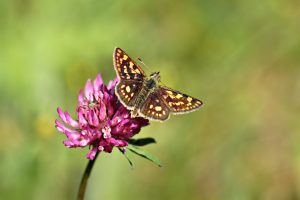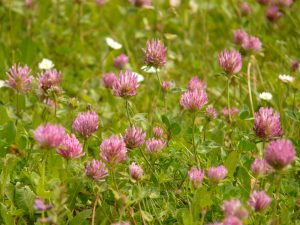Are you looking for fodder for your livestock? Do you need to revitalise your soil? When it comes to form and function, there’s no fodder crop quite like red clover. A high-yield crop suited to Australia’s more temperate regions, red clover provides an excellent option when it comes to animal feed.
Let’s have a look at what makes red clover tick.
Plant Makeup
A perennial (and sometimes biennial) legume, Red clover (Trifolium Pratense) was originally a native of Europe and Northern Asia. It is now cultivated for forage worldwide, thanks to its ability to grow quickly and deliver high yields.
Its leaves have three leaflets, each being 15-30mm long and 8-15mm wide. The basal leaves have a long leaf stalk, while the upper leaves have short or no stalks. They are green, but feature a characteristic pale crescent on the outer half of the leaf.
The flowering head is made up of a group of flowers, each 10-15mm long and coloured a rose-purple. A small oblong seed pod is hidden within the flower, opening as the flower withers to shed the seeds.
Benefits
Red clover is most commonly chosen as fodder because of its aforementioned high-yield. It can sustain many more head of livestock than other fodder options, and grows quickly and densely given the right conditions. It can be used for pasture, hay or silage. It will cope well with high traffic and heavy grazing, and is extremely quick and easy to establish from seed, growing vigorously from the get-go.
It is a legume suited to temperate Australian conditions, and as such, copes with frosts and cold admirably. While it does best in full sun, it won’t be adversely affected by shade. It is also largely unfussed by a soil’s fertility levels, and will grow in all but the most challenging conditions.
What’s more, if you plant it in poor soil, red clover will work to improve it. Red clover is well known as a source of nitrogen for any infertile ground. As such, it is often used as part of a crop rotation program, topping up the nitrogen levels of soils that may have been depleted over several years of cropping other plants.
Red clover is often used as a cover crop or “green manure” to continually fixate nitrogen into the soil. It can be planted at the base of fruit trees or grape vines in order to aid their yields, and will also provide a barrier against invasive weeds.
It’s also great for the biodiversity of your land. Planting red clover will encourage birds, bees and other wildlife to bring life to your property.
Disadvantages
Being a European native, much of Australia is off-limits for red clover. It doesn’t cope well with heat, and ideally needs consistent rainfall or irrigation throughout the year. Red clover will struggle in the sub-tropical and tropical areas or Western Australia, Queensland and the Northern Territory.
While a relatively unfussy plant when it comes to soil quality, red clover has been known to struggle with alkaline soils. If your soil has a pH of 7+, you may need to prepare it with a soil mixture prior to sowing red clover.
If planted as a stand-alone crop, red clover has been known to occasionally bloat animals. This being the case, many pastoralists choose to combine their red clover with a grass. Bloating most often occurs when the clover is used as hay.
Planting
Red clover is best planted in either autumn or spring, and will be aided by a good soaking when sown. By using one kilogram per square acre you’ll get your crop off to a good start.
To learn more about McKays’ Red Clover, or for any other questions, contact the friendly team at McKays today.


